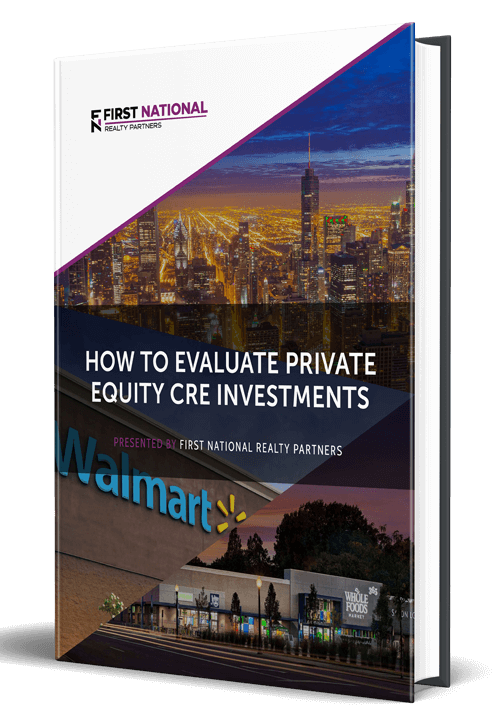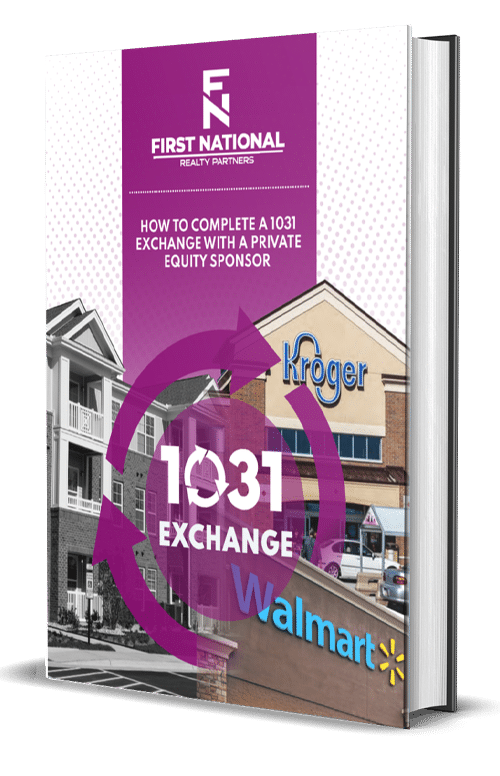Individuals interested in making an investment in a commercial real estate asset typically do so through a fund or an individually “syndicated” deal structure. In each case, the deal or investment goes through a number of phases before it is finalized.
In this article, we are going to describe the phases of an individually syndicated real estate deal. In doing so, we will describe what each one is, how it works, why it matters, and how it fits within the entire lifecycle of a deal. By the end, the goal is for readers to have the information needed to determine if an individually syndicated deal is a suitable fit for their own investment preferences.
At First National Realty Partners, we are an individual deal syndicator who specializes in the acquisition and management of grocery store anchored retail centers. If you are an accredited investor and would like to learn more about our current investment opportunities, click here.
What is a Real Estate Syndication?
In order to understand the phases of a real estate syndicated deal, it is first necessary to understand what a syndicated structure is.
Individual investors who want to own commercial real estate face two hurdles. First, commercial properties are prohibitively expensive for individual investors (for context, the properties that we purchase are usually in the $20MM – $30MM range). Second, they take a lot of time, expertise, and experience to manage once purchased. The syndication structure addresses both of these issues.
A syndication is a real estate investment deal structure that involves two groups of participants. The General Partner or “GP” is the deal leader who is responsible for finding suitable investment properties, performing due diligence on them, arranging financing for their purchase, and managing the property once the purchase is complete. In short, they do all of the heavy lifting to find and manage a commercial property.
The other group, known as Limited Partners or “LPs”, consists of individual investors who have capital to invest. These individuals invest their capital with the General Partner with the hope of earning a return over time. They have no say in the day-to-day operations of the property, which makes them passive investors earning passive income.
So, this structure addresses the cost issue because individual investors are able to purchase a fractional share instead of the whole property and it addresses the time issue because the General Partner does all of the hard work to manage the asset and the investment.
Although common, this can be a complex real estate deal structure with several distinct phases.
The Phases in Real Estate Syndication
Although each deal is unique, there are four phases that are typical of a real estate syndication. Each is described in detail below.
Phase 1: Origination
The origination phase of a loan syndication is the first step and it is usually taken by the company acting as the General Partner. There are a number of important activities that take place in this phase, but the most notable are:
- Finding a Property: The most important element of the Origination phase is to find a property to purchase. While the task itself is simple, finding the right property can take a significant amount of time and effort. Often, it means calling owners, brokers, other investors, and lenders to find the right opportunities.
- Due Diligence & Research: Once a property has been found, even more effort must be put into doing research on the market and on the property to ensure it is in good operating order.
- Financing: The General Partner must line up debt financing from a lender and begin the process of starting to line up equity financing from investors.
- Paperwork: The General Partner must prepare and submit a significant amount of paperwork to comply with securities laws and to present the opportunity to investors. Key documents include the Operating Agreement, Private Placement Memorandum, and Offering Memo.
When the origination phase is complete, the property should be under contract and all documentation should be prepared.
Phase 2: Marketing
The goal of the marketing phase is to raise the needed equity capital to close the deal. For example, a rental property with a purchase price of $10MM may get a $7.5MM loan, which means that the General Partner needs to raise $2.5MM in investor capital from individual investors.
Marketing efforts are somewhat limited by the type of syndication pursued by the General Partner. Under rules set by the Securities and Exchange Commission, a “503(b)” syndication allows a General Partner to raise an unlimited amount of money from Accredited Investors and up to 35 “sophisticated” investors. But, they are not allowed to create an active solicitation campaign for the investment opportunity. A 506(c) syndication allows General Partners to advertise as much as they want as long as they only raise capital from Accredited Investors, who meet certain income and/or net worth requirements.
In the current fundraising environment, most General Partners opt for the 506(c) option and utilize all available channels to market their offering, particularly social media.
A successful marketing phase ends when the capital raise is complete and the purchase is consummated.
Phase 3: Operation
Finding and buying a property represents only half of the effort needed to achieve a successful real estate syndication outcome. Once it is purchased, it has to be operated.
In a real estate syndication, the General Partner is responsible for managing a property’s day to day operations. This includes things like collecting rent, managing maintenance requests, cutting the grass, shoveling the snow, and tracking delinquent rent payments. In addition, the General Partner must manage the logistics of distributing property cash flow to investors and tax documents at the end of each year.
In some cases, these tasks are managed by a third-party property management company. In other cases, like ours, it is handled in house, which helps to save investors money because fees aren’t paid to a third party.
The property operation phase does not “end” per se. Instead it is ongoing for the duration of the investment holding period. It could be a year or ten years, but the trigger for moving to the next phase is when the General Partner determines that it is time to sell the property.
Phase 4: Liquidation Phase
A General Partner may determine that it is time to sell the property for a number of different reasons. For example, they may want to take advantage of strong market conditions or the property may just reach the end of the holding period outlined in the business plan. There are a number of important tasks that must be completed to sell a property:
- Prepare: To get top price for the property, General Partners must take great pains to prepare it for sale. This means making sure that the property is in good physical condition and completing renovations if it isn’t. It also means making sure tenant leases are signed or renewed, vacant space is filled, and landscaping is perfect.
- Hire Representation: The vast majority of commercial properties trade hands through a real estate broker. A broker is an individual hired to represent the owner’s interest in the deal. They are real estate market experts with the relationships and resources needed to sell the property.
- Negotiate: In an ideal scenario, the broker finds great success in marketing the property for sale and receives multiple offers. In such a case, the owner, broker, and buyer work together to hammer out the details of the sale.
- Close: Once a deal is hammered out, the last step is to close the deal. This means working with the broker and buyer to finalize the transaction, transfer the funds, and pay out investors.
- Wind Down: Once the property has been sold, the last step is to unwind the limited liability company that owned the property. It also means completing all of the paperwork needed to close out the entity and managing all final distributions to investors for any money they are entitled to.
Once the entity has been closed out and all funds have been disbursed, the syndication lifecycle is complete and the limited partnership is shut down.
How This Simplifies Investing
For individual investors, the implication of this structure is clear. It greatly simplifies the task of owning and operating a commercial real estate asset. By purchasing a fractional share of the property and outsourcing all identification and management tasks to the General Partner, individuals get all of the benefit of real estate ownership without the hassle.
Put another way, the syndicated structure allows individual investors to earn passive income from the real estate syndication because the General Partner does all of the hard work.
In addition, the syndication structure allows an investor to achieve a higher level of portfolio diversification than they otherwise could in a direct ownership scenario. For example, imagine that an individual had $100k to invest. In a direct ownership scenario, they may be able to purchase a single-family rental directly and use this entire amount as the down payment. This is good because they have direct control of the house, but bad because they have to do all of the work of managing it. In addition, 100% of their capital is tied up in a single property, which can raise the risk profile of the deal.
In a syndicated structure, the individual could take the same $100,000 and invest $25,000 in four different real estate deals. These deals could be diversified by location, asset class, general partner, or property type. This scenario provides more diversification, eliminates the need for involvement in day to day operations and spreads the risk over a larger group of investors, reducing the risk for each individual investor.
Summary
A commercial real estate syndication is a deal structure that involves two parties, the General Partner and Limited Partners, and allows individual investors to purchase a fractional share of a commercial real estate property.
For investors, the primary benefits of a syndication are the lower minimum investment and outsourcing of management tasks to the General Partner. In addition, there are some portfolio diversification and tax benefits.
There are four phases to a syndicated transaction: origination, marketing, operation, and liquidation.
In the origination phase, the General Partner is responsible for finding, underwriting, and financing the purchase of an asset.
In the Marketing phase, the General Partner is responsible for creating all of the property’s marketing materials and using it to raise the equity required to close the deal.
In the Operating phase, the General Partner is responsible for managing the say to day operations of the property.
Finally, in the Liquidation phase, the General Partner is responsible for preparing the property for sale, hiring a broker, and negotiating the conditions and price of the sale.
Interested In Learning More?
First National Realty Partners is one of the country’s leading private equity commercial real estate investment firms. With an intentional focus on finding world-class, multi-tenanted assets well below intrinsic value, we seek to create superior long-term, risk-adjusted returns for our investors while creating strong economic assets for the communities we invest in.
If you are an Accredited Real Estate Investor and would like to learn more about our investment opportunities, contact us at (800) 605-4966 or info@fnrpusa.com for more information.






